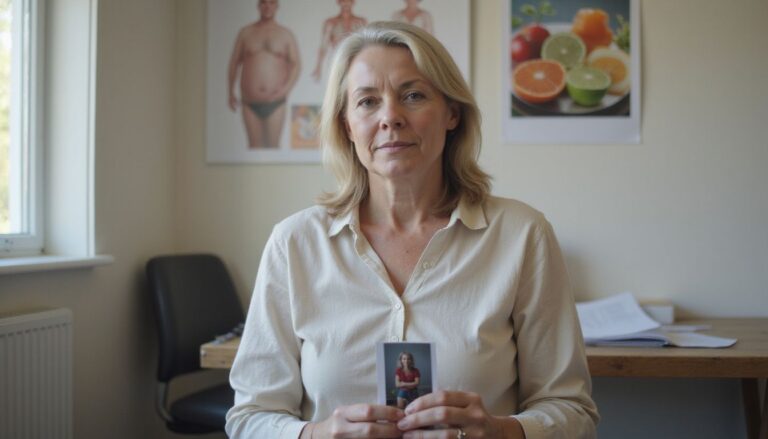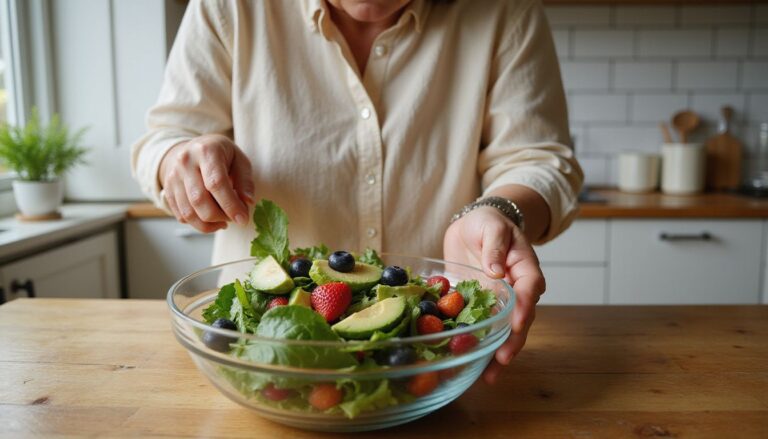Diet Plan For Breastfeeding Mothers: Lose Weight With Ease
Our Nutrition Assistant AI Suite will transform your body. You will lose fat, get toned, and build muscle. Gain confidence and optimal health.
Many new mothers want to lose weight while keeping energy steady and milk supply strong. A simple breastfeeding diet plan can help you meet both goals without risking your health or your baby’s nutrition.
You will see how to build a balanced diet with nutrient-dense foods, set a safe calorie target, and choose easy meal ideas that support lactation. These tips help you find what works for you while caring for a newborn.
Keep reading for clear steps and smart, time-saving tips.
Key Takeaways
- Breastfeeding uses about 500 to 700 extra calories daily. Most mothers do best with at least 1,800 calories per day to support energy and milk supply.
- A balanced diet includes lean protein, whole grains, vegetables, fruits, healthy fats, and about 12 cups of water each day.
- Avoid drastic calorie cuts, heavily processed snacks, very sugary foods and drinks, very low-carb plans like keto, and limit caffeine and alcohol.
- Key nutrients include protein, calcium with vitamin D, iron with vitamin C, and omega-3 fats from salmon or flaxseed.
- Light to moderate exercise, such as walking, yoga, or swimming, supports gradual postpartum weight loss after medical clearance.

Why Is a Healthy Diet Important While Breastfeeding?

Poor nutrition and very low calorie intake can reduce milk production, which makes it harder to meet your baby’s needs. Your food choices affect your health and the quality of breast milk, even though milk usually adapts to support your infant.
Extreme calorie restriction may look like a quick fix, but it can harm milk supply and drain your energy. Choosing nutrient-dense foods helps you recover, stay active, and lose weight slowly and safely.
Lean proteins, vegetables, fruits, whole grains, and healthy fats give you steady energy while keeping milk production stable. This approach also supports your baby’s vitamin and mineral needs.
“Healthy eating is key for both mother’s recovery and the baby’s growth,” says the American Academy of Pediatrics.[1] For major diet changes, consult a registered dietitian or your healthcare provider.
How Does Breastfeeding Influence Weight Loss?
Breastfeeding can increase calorie burn and help with postpartum weight loss. Your daily diet shape, especially protein and fluid intake, can support energy while protecting your milk supply.
How Many Calories Does Breastfeeding Burn?
Breastfeeding can burn 500 to 700 calories per day. Your body uses these calories to make milk and may tap into fat stored during pregnancy.
If you have already lost some pregnancy weight, you may need 500 to 600 extra calories to maintain energy and milk output. Many breastfeeding meal plans suggest at least 1,800 calories a day for safe progress.
After your baby starts solids, usually around 6 months, calorie needs often drop. During my own postpartum months, frequent nursing helped me return to my pre-pregnancy weight without strict dieting. I watched my baby’s weight gain as a simple check on my milk supply.
Knowing how your metabolism shifts can guide daily choices. Next, see how hormones play a role.
What Hormonal Changes Affect Metabolism During Breastfeeding?
Breastfeeding raises your metabolic rate because your body is making milk around the clock. Hormonal shifts that support lactation also increase energy needs, which can aid gradual weight loss.
Food intake and these hormones work together. Severe calorie cuts can disrupt this balance, which may slow metabolism or lower supply. Very low-carb plans like strict keto are not advised during lactation due to rare risks, including lactation ketoacidosis reported in recent case reviews.[2]
Feeding often and eating balanced meals supports a healthy metabolism and steady milk production.
Balanced nutrition supports healthy hormones during breastfeeding.
General Guidelines for a Breastfeeding Diet
A helpful plan for breastfeeding moms focuses on nutrition, energy, and ease. Simple, steady choices at meals and snacks keep milk flowing and support safe weight loss.
Which Nutrient-Dense Foods Should I Prioritize?
Include lean protein two to three times daily. Eggs, beans, rotisserie chicken, and turkey are easy options that support milk production. Add dairy or fortified plant milks, yogurt, and almonds to help meet calcium needs.
Choose at least three servings of vegetables a day, with extra points for dark green and orange options like spinach and bell pepper. Pick whole grains such as oats, brown rice, and whole-grain bread to steady energy and reduce overeating.
Healthy fats from avocado, olive oil, nuts, chia, and flax help you feel satisfied. Snack ideas include a berry smoothie, dried fruit with nuts, or a protein bar you trust. I often add black beans to salads and oats to breakfast to make meals more filling.
Next, learn why processed and sugary foods can stall your progress.
Why Avoid Processed and Sugary Foods While Breastfeeding?
Highly processed foods, such as fast food, packaged snacks, sugary cereals, and fried items, often contain added sugar, refined oils, and extra sodium. These add calories without helpful nutrients.
Soda, sweet teas, and energy drinks can add hundreds of calories in a day. Refined grains like white bread and pastries offer less fiber, which can leave you hungrier later.
Excess salt in processed meats and canned soups can cause bloating. High-sugar snacks spike blood sugar, then cause a crash. That crash can trigger more cravings and less energy.
Artificial sweeteners, like aspartame or sucralose, are best limited since long-term effects during lactation are not fully known. Limiting processed items supports your milk quality and your weight goals.
How Much Water Should I Drink While Breastfeeding?
Aim for at least 12 cups, or 96 ounces, of water daily. Hydration supports milk production and keeps energy steady.
Follow your thirst cues. You may need more fluid in hot weather or with regular exercise. Extra water will not boost supply, but too little can cause fatigue and headaches.
Keep a bottle within reach during meals and feedings. Adding cucumber or apple slices can make water more appealing. Next, see how small, frequent meals make a difference.
Why Eat Small, Frequent Meals?
Eating three meals and two snacks each day helps maintain energy and mood. Skipping meals can slow metabolism and stress your supply.
Spacing smaller, balanced meals supports stable blood sugar and fits a newborn’s rhythm. Nutrient-dense choices, like nuts, legumes, lean protein, and leafy greens, help you feel satisfied and cut the urge to overeat.
This pattern gives you and your baby a steady stream of nutrition during the postpartum period.
What Are the Key Nutrients for Breastfeeding Mothers?
A nutrient-dense diet fuels your energy and supports your baby’s growth. Focus on protein, calcium with vitamin D, iron with vitamin C, and omega-3 fats.
How Does Protein Support Energy and Milk Production?
Protein helps you recover after delivery and supports milk production. Include protein foods in meals and snacks at least two or three times a day.
Lean meats, dairy, beans, eggs, and chickpeas are strong choices. Protein powders and bars can help on busy days if they fit your plan.
Protein also helps you feel full, which can reduce overeating while you lose weight at a safe pace.
Why Are Calcium and Vitamin D Important for Bone Health?
Calcium and vitamin D support strong bones for you and your baby. You lose some calcium through milk, so needs increase while nursing.
Dairy foods like milk, yogurt, and cheese are reliable sources. Fortified plant milks and oily fish can help with vitamin D. If you avoid dairy, lean on leafy greens, fortified foods, and a supplement if your provider recommends it.
During my breastfeeding months, adding yogurt and a handful of almonds a few times a week made it easier to meet my goals.
How Does Iron Help Prevent Fatigue?
Iron helps your body make red blood cells, which carry oxygen. Low iron can lead to anemia, a common cause of fatigue and weakness.
Good sources include lean beef, beans, lentils, and leafy greens. Pair plant iron with vitamin C foods, like tomatoes or oranges, to improve absorption.
Watch for warning signs like ongoing tiredness or lightheadedness. A high-iron meal pattern supports your health and your baby’s well-being.
What Are the Benefits of Omega-3 Fatty Acids for Brain Health?
Omega-3 fats, especially DHA, support your baby’s brain and nervous system development. Aim for fish like salmon two to three times each week, and avoid high-mercury fish such as shark and swordfish.
Plant options, including flaxseeds and walnuts, also supply omega-3s. If you do not eat fish, ask your provider about a DHA supplement.
Omega-3s may also support your mood during the postpartum phase.
What Foods Should Breastfeeding Mothers Include?
A wide variety of nutrient-rich foods supports steady energy and helps prevent overeating. Here are meal and snack ideas that fit a breastfeeding meal plan.
Why Eat Fruits and Vegetables?
Aim for at least three servings of vegetables and two servings of fruit each day. Apples, oranges, and grapes make easy, hydrating snacks.
Colorful produce provides vitamins, minerals, and fiber that support heart health and digestion. Pre-washed salad greens and frozen veggies can save time on busy days.
After my baby arrived, carrot sticks and apple slices helped me stay full between meals.
What Are the Benefits of Whole Grains?
Whole grains such as oatmeal, brown rice, whole-grain bread, and high-fiber tortillas provide steady energy and fiber. These grains also supply B vitamins and iron for energy production.
Swapping refined grains for whole grains can aid weight loss and stabilize blood sugar. Starting the day with oats helped me avoid sugary snacks later.
Which Lean Proteins Are Best?
Quick options include deli turkey, rotisserie chicken, and hard-boiled eggs. Frozen turkey burgers cook fast and are helpful for meal prep.
Chickpeas and black beans offer plant protein plus fiber. Try to include lean protein in two or three meals a day to meet your needs.
Batch-cooking chicken, beans, or eggs can set you up for several days of balanced meals.
Why Choose Healthy Fats Like Avocados, Nuts, and Seeds?
Healthy fats improve satiety and support vitamin absorption. Avocados, nuts, and seeds are excellent sources.
Flaxseeds and chia seeds provide plant omega-3s, which support your baby’s brain health. Almonds add healthy fats and a helpful source of calcium.
Try 100 percent dark chocolate in small portions for a satisfying treat. Limit processed oils and trans fats to protect heart health and support gradual weight loss.
What Foods Should Breastfeeding Mothers Avoid or Limit?
Some foods and drinks can affect supply or your baby’s comfort. These guidelines help you make safer choices while nursing.
Why Limit High-Sugar Snacks and Drinks?
Candy, pastries, and sugary granola bars add calories but few nutrients. Sweetened drinks like soda and bottled teas raise calorie intake without helping your milk.
Too much sugar can cause energy crashes and mood swings. Cutting back supports steadier blood sugar and easier weight loss.
Choose nutrient-dense snacks, like fruit with almonds or a protein bar you trust. Whole foods help you feel full and nourished.
How Much Caffeine Is Safe During Breastfeeding?
Most experts suggest limiting caffeine to 1 to 2 cups per day. That total includes coffee, caffeinated tea, soda, and chocolate.
Newborns process caffeine slowly. Too much can cause fussiness or poor sleep. Watch your baby’s cues and adjust your intake if needed.
Decaf is a safer swap. Skip energy drinks, which often contain high sugar and excessive caffeine. Check medication labels for hidden caffeine.
Is It Safe to Drink Alcohol While Breastfeeding?
Alcohol passes into breast milk at about the same level as in your blood. Drinking can reduce milk production and may affect your baby if you nurse too soon after drinking.
Wait at least 2 to 3 hours after one standard drink before breastfeeding. Frequent or heavy drinking can harm supply and disrupt your baby’s feeding pattern.
For most mothers, avoiding alcohol is the safest choice. During my own journey, planning feeds around an occasional glass of wine kept my baby safer and kept me mindful.
How Many Calories Should a Breastfeeding Mom Eat?
Eating at least 1,800 calories per day helps protect your milk supply and energy. Many mothers need 500 to 600 extra calories, especially if they are active.
For weight loss, reduce intake by about 300 to 500 calories a day, then reassess. Very low calorie diets can cause fatigue and may lower supply. If your baby is growing well and you feel energetic, you are likely on track.
As solids increase around 6 months, calorie needs often decline. If you notice warning signs like dizziness or a big drop in supply, talk with your provider.
What Does a Sample 7-Day Diet Plan Look Like for Breastfeeding Mothers?
A simple weekly plan should be realistic, nutrient dense, and easy to prep. Mix and match these ideas to fit your taste and schedule.
What Are Balanced Meals with Lean Protein and Vegetables Like?
Build each plate with one lean protein and several vegetables. Rotisserie chicken, deli turkey, eggs, or frozen turkey burgers are fast proteins.
Pair them with pre-washed lettuce or steam-in-bag veggies. Add a whole grain base, like brown rice or quinoa, for lasting energy.
Limit fried foods and heavily processed meats. Batch-cooking proteins and using frozen vegetables can make busy days easier.
How to Include High-Iron Meals with Leafy Greens and Lentils?
Stir spinach, kale, or chard into omelets, soups, and smoothies for a simple iron boost. Add cooked lentils to salads and stews for extra protein and fiber.
Top leafy salads with vitamin C sources, such as red bell peppers or tomatoes, to improve plant iron absorption. Fortified grains and cereals can help fill gaps.
Vegetarian mothers can lean on beans, lentils, and greens to support energy and supply.
What Are Good Plant-Based Options with Tofu and Quinoa?
Tofu is a versatile protein. Bake or stir-fry it for bowls, wraps, or salads. Swap tofu for meat in many recipes.
Quinoa is a complete protein that also provides fiber. Combine it with chickpeas, black beans, nuts, and seeds for filling, balanced meals.
If you do not eat animal foods, discuss a vitamin B12 supplement with your provider.
How to Prepare Calcium-Rich Meals with Yogurt and Almonds?
Stir yogurt with fresh fruit for a fast breakfast. Choose low-fat dairy or fortified non-dairy yogurt if you avoid full-fat dairy.
For snacks, add almonds to oatmeal or trail mixes. Fortified plant milks work well in smoothies and cereals to raise calcium without excess saturated fat.
Which Foods Provide Omega-3 Rich Meals with Salmon and Flaxseeds?
Salmon is a top source of DHA. Aim for salmon two to three times weekly. Sardines and mackerel are helpful too, and avoid high-mercury fish.
Plant sources include ground flaxseeds, walnuts, and chia seeds. I often add flaxseeds to yogurt or a smoothie for a quick boost.
Omega-3s can also support mood and mental clarity in the early months.
How to Focus on Hydration and Nutrient Variety?
Drink at least 12 cups of water daily. Carry a reusable bottle and refill often, especially after activity or in hot weather.
Rotate fruits, vegetables, grains, and proteins through the week for better coverage. Use both raw and cooked produce to add texture and variety.
Blend smoothies with frozen berries or spinach and yogurt to combine hydration and nutrients. Frozen produce is a time saver and often just as nutritious as fresh.
Choose snacks like almonds with sliced apples. These support steady blood sugar and help you avoid sugary choices.
What Are Comfort Meals with Healthy Snacks?
Comfort foods can still be nourishing. Try sweet potatoes or warm oatmeal for long-lasting energy.
Mix pre-washed lettuce with rotisserie chicken for a quick salad. Hard-boiled eggs and nuts offer protein and healthy fats for staying power.
Apples, oranges, and grapes make portable snacks. If you want dessert, a square of 100 percent dark chocolate can satisfy without lots of sugar.
How Can I Manage Weight Loss While Breastfeeding?
You can lose weight safely while maintaining supply with daily habits that feel manageable. Small steps add up over time.
How Does Frequent Breastfeeding Help Burn Calories?
Frequent nursing can use 500 to 700 calories each day. Your body often draws on stored fat to meet this demand.
More feeds usually mean more calories used. Pair regular nursing with a balanced diet to support safe weight loss and your baby’s needs.
What Light to Moderate Exercises Are Safe for Breastfeeding Moms?
- Start with yoga or gentle stretching for 20 to 30 minutes a day after your provider approves.
- Try brisk walking. Work toward 150 minutes of moderate activity each week.
- Choose swimming for low-impact movement that is easy on joints.
- Use bodyweight moves like squats and lunges to build strength without equipment.
- Plan exercise after a feeding to reduce breast discomfort.
- Increase time and intensity slowly. Stop if you feel pain, dizziness, or extreme fatigue.
- Wait 6 to 12 weeks for vigorous workouts like running, and get medical clearance first.
- Daily stroller walks and short yoga flows helped my mood and fit well around feedings.
Why Is Getting Enough Sleep Important for Metabolism?
Getting 7 to 9 hours of sleep supports healthy metabolism and appetite control. Lack of sleep can raise cortisol, a stress hormone that increases cravings for sugary foods.
Tools like the Momcozy DreamSync Smart Baby Sound Machine (79.99 dollars, discounted from 99.99 dollars) may help improve rest. Quality sleep also supports emotional health and physical healing after birth.
Safe weight loss methods are preferred over oral weight loss medications during breastfeeding. Ask your provider before using any drug or supplement.
Why Avoid Extreme Calorie Restriction During Breastfeeding?
Eating less than 1,800 calories per day can reduce milk supply and energy. Your baby depends on your milk for vital nutrients.
Aim for gradual loss, about one pound each week. Skipping meals or fasting can trigger fatigue and a drop in supply.
Snack on Greek yogurt, fruit, or almonds to keep energy steady. If you plan major changes, talk with your healthcare provider first.
What Are Common FAQs About Weight Loss While Breastfeeding?
These answers address frequent questions from breastfeeding moms who are trying to lose weight while protecting milk production.
Will Dieting Affect My Milk Supply?
Very strict dieting can lower milk supply. Eat at least 1,800 calories per day and focus on whole foods to protect lactation.
Losing about one pound per week is considered safe. Drink about 12 cups of water daily to support hydration and energy.
If you are unsure about changes, speak with your healthcare provider for guidance that fits your situation.
Can Low-Carb Diets Work While Breastfeeding?
Moderate carb reduction can work if you keep calories and nutrients adequate. Include vegetables, fruits, lean proteins, whole grains, and healthy fats.
Avoid cutting entire food groups or slashing calories. Slow and steady loss supports both your health and your baby’s needs.
For a specific plan, consult a registered dietitian who understands lactation.
Is Intermittent Fasting Safe During Breastfeeding?
Intermittent fasting is usually not recommended while nursing. Long gaps without food can reduce calories below your needs and may lower supply.
Eat regularly, drink about 12 cups of water daily, and aim for a balanced plate. After I skipped meals early on, my energy dipped and my baby seemed fussier, so I returned to small, frequent meals.
Can I Take Weight Loss Supplements While Breastfeeding?
Weight loss supplements are not recommended for breastfeeding mothers. Many products include stimulants or herbs that pass into milk and may affect your baby.
Gradual loss with whole foods, fluids, and activity is safer. Talk with your provider before taking any supplement.
What Are Additional Tips for Long-Term Success?
Progress comes from habits you can keep. Aim for consistency over speed, and get support when needed.
Why Work with a Registered Dietitian?
A registered dietitian can tailor a practical plan to your needs and schedule. They help you hit nutrient targets for milk production while losing about one pound per week.
Dietitians can also flag possible allergens and monitor both your intake and your baby’s growth. That support makes healthy routines easier to maintain.
How to Be Patient and Focus on Gradual Weight Loss?
Target slow loss, about one pound each week. Patience lowers stress and protects supply.
Build routines you enjoy, such as 30 minutes of moderate movement most days. Tracking small wins can keep you motivated without pressure.
How to Prioritize Your Health and Your Baby’s Well-Being?
Eat at least 1,800 calories daily, focus on whole foods, and drink plenty of water. Regular meals and snacks help keep energy up and milk supply steady.
Check in with your healthcare provider before big diet changes. A balanced diet plan supports your recovery and your baby’s growth.
Conclusion
A clear diet plan for breastfeeding mothers can support weight loss while protecting milk supply. Choose nutrient-dense whole foods, get enough protein, and stay hydrated.
Limit processed foods and added sugars to help weight loss while maintaining energy. Add light activity and small, frequent meals for steady progress.
Make gradual changes instead of strict cuts. If you want expert support, a registered dietitian can personalize a breastfeeding diet that fits your life. This is general education, not medical advice. Always consult your healthcare provider for personal guidance.
Sources: American Academy of Pediatrics, Centers for Disease Control and Prevention, and peer-reviewed case reviews on lactation ketoacidosis.
FAQs
1. How can a breastfeeding mother lose weight safely while following a diet plan?
A breastfeeding mother can lose weight safely by eating nutrient-rich foods, drinking enough water, and avoiding crash diets. Research from the Academy of Nutrition and Dietetics shows that gradual weight loss of about one pound per week does not affect milk supply. Focus on whole grains, lean proteins, fruits, and vegetables for balanced nutrition.
2. What foods should be included in a diet plan for breastfeeding mothers?
A diet plan for breastfeeding mothers should include foods high in protein, calcium, iron, and healthy fats. For example, eggs, dairy, beans, leafy greens, and nuts provide essential nutrients. According to the Centers for Disease Control and Prevention, these foods support both the mother’s health and the baby’s growth.
3. Are there foods breastfeeding mothers should avoid to help with weight loss?
Breastfeeding mothers should limit processed foods, sugary drinks, and high-fat snacks. Studies published in the Journal of Human Lactation suggest that these foods add empty calories and do not support healthy weight loss. Choosing whole foods helps maintain energy and supports milk production.
4. Can exercise be part of a weight loss plan for breastfeeding mothers?
Exercise can be part of a weight loss plan for breastfeeding mothers if approved by a healthcare provider. Walking, swimming, and gentle stretching are safe options. The American College of Obstetricians and Gynecologists recommends starting with light activity and increasing intensity as the body heals after childbirth.
Summary: A safe diet plan for breastfeeding mothers includes nutrient-dense foods, gradual weight loss, and regular physical activity. Avoiding processed foods and focusing on balanced meals supports both mother and baby. Personal experience shows that small, consistent changes lead to lasting results.







